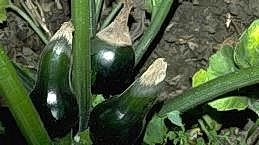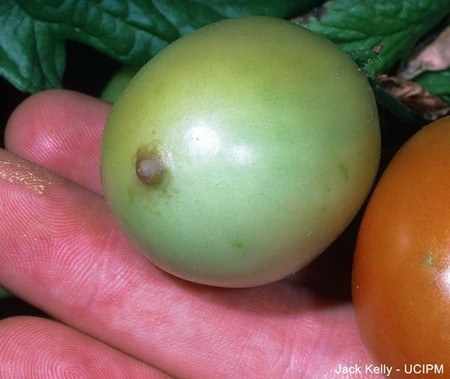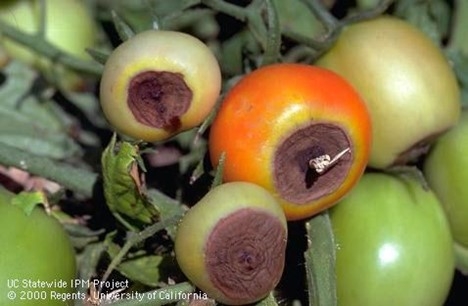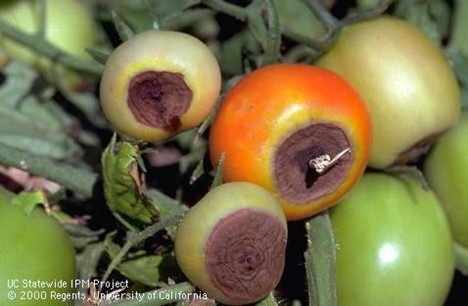Posts Tagged: Blossom end rot
Fighting Blossom End Rot
Are your tomatoes not looking their beautiful best this year? They may be suffering from blossom end rot. Blossom end rot first appears as a small, water-soaked spot on the blossom end of a tomato. The spot enlarges, darkens, and becomes...
Lawn-pocalypse! Surviving Drought
Ah, summer! The season of sunburns, pool parties, and… lawn droughts. If your once lush, green carpet now looks like a crunchy brown doormat, you're not alone. Let's dive into why your yard is staging a dramatic death scene and what you can do to...

Bermuda grass and weeds overtaking drought stressed turf grass.
Blossom End Rot
This post is a rerun from 2023.
Have you noticed tomatoes that have round, water-soaked spots on the bottom? Blossom end rot (BER) is a frustrating problem that can be quite common in vegetable gardens, as it can affect tomatoes, peppers, and squash. You might notice it after a few very hot days. It usually starts on green fruit as a small, discolored spot on the end opposite the stem that might look water soaked. The spot enlarges and tissues dry out, becoming sunken, collapsed, and leathery.
Some tomato varieties, especially paste tomatoes, are affected more than others, but all varieties except cherry tomatoes seem to be susceptible if conditions are conducive. It is more likely to occur earlier in the season when plants are rapidly growing, but it can also show up later in the season when we have hot, dry weather.
Blossom end rot results from a low level of calcium in the fruit and a lack of water balance in the plant. Most of our soils have plenty of available calcium so there is no need to add more. Fluctuations in irrigation and/or heavy application of nitrogen are often the culprits in this condition. To reduce blossom end rot, monitor soil moisture to make sure the root zone neither dries out nor remains saturated. Follow recommended rates for vegetable fertilizers, using organic fertilizers.
Improvement in irrigation practices usually results in the problem going away. Rather than watering on a schedule, you should check the soil to determine its moisture level. Either by digging down into the soil without disturbing the roots or using a moisture meter, check to make sure the entire root zone is moist but not soggy. Use mulch around the plants to help maintain soil moisture, but make sure the mulch isn't right against the base of the plants.
Blossom end rot is not caused by a pathogen, so there are no pesticide solutions.
To reduce blossom-end rot:
• Use cover crops in the off season to increase water-holding organic matter in the soil.
• Irrigate before periods of hot weather.
• Don't disturb the root area.
• Don't over fertilize. Too much nitrogen during the early fruiting period can tie up calcium and make BER worse. Manure, especially poultry manure, can make it worse.
Vegetables affected by blossom end rot are still edible if they haven't begun to get moldy. Just cut away the discolored area.
More information about blossom end rot:
http://ipm.ucanr.edu/PMG/GARDEN/VEGES/ENVIRON/blossomendrot.html
Information about growing tomatoes in the home garden: https://anrcatalog.ucanr.edu/pdf/8159.pdf
Help Desk of the UC Master Gardeners of Contra Costa County (SEH)

blossom end rot2

blossom end rot3-450
Blossom End Rot
Have you noticed tomatoes that have round, water-soaked spots on the bottom? Blossom end rot (BER) is a frustrating problem that can be quite common in vegetable gardens, as it can affect tomatoes, peppers, and squash. You might notice it after a few very hot days. It usually starts on green fruit as a small, discolored spot on the end opposite the stem that might look water soaked. The spot enlarges and tissues dry out, becoming sunken, collapsed, and leathery.
Some tomato varieties, especially paste tomatoes, are affected more than others, but all varieties except cherry tomatoes seem to be susceptible if conditions are conducive. It is more likely to occur earlier in the season when plants are rapidly growing, but it can also show up later in the season when we have hot, dry weather.
Blossom end rot results from a low level of calcium in the fruit and a lack of water balance in the plant. Most of our soils have plenty of available calcium so there is no need to add more. Fluctuations in irrigation and/or heavy application of nitrogen are often the culprits in this condition. To reduce blossom end rot, monitor soil moisture to make sure the root zone neither dries out nor remains saturated. Follow recommended rates for vegetable fertilizers, using organic fertilizers.
Improvement in irrigation practices usually results in the problem going away. Rather than watering on a schedule, you should check the soil to determine its moisture level. Either by digging down into the soil without disturbing the roots or using a moisture meter, check to make sure the entire root zone is moist but not soggy. Use mulch around the plants to help maintain soil moisture, but make sure the mulch isn't right against the base of the plants.
Blossom end rot is not caused by a pathogen, so there are no pesticide solutions.
To reduce blossom-end rot:
• Use cover crops in the off season to increase water-holding organic matter in the soil.
• Irrigate before periods of hot weather.
• Don't disturb the root area.
• Don't over fertilize. Too much nitrogen during the early fruiting period can tie up calcium and make BER worse. Manure, especially poultry manure, can make it worse.
Vegetables affected by blossom end rot are still edible if they haven't begun to get moldy. Just cut away the discolored area.
More information about blossom end rot:
http://ipm.ucanr.edu/PMG/GARDEN/VEGES/ENVIRON/blossomendrot.html
Information about growing tomatoes in the home garden: https://anrcatalog.ucanr.edu/pdf/8159.pdf
Help Desk of the UC Master Gardeners of Contra Costa County (SEH)

blossom end rot2

blossom end rot3-450
Climate-Change Resources
University of California UC ANR Green Blog (Climate Change and Other Topics) https://ucanr.edu/blogs/Green/index.cfm?tagname=climate%20change (full index)
Examples:
- Save Trees First: Tips to Keep Them Alive Under Drought https://ucanr.edu/b/~CdD
- Landscaping with Fire Exposure in Mind: https://ucanr.edu/b/~G4D
- Cities in California Inland Areas Must Make Street Tree Changes to adapt to Future Climate https://ucanr.edu/b/~oF7
Drought, Climate Change and California Water Management Ted Grantham, UC Cooperative Extension specialist (23 minutes) https://youtu.be/dlimj75Wn9Q
Climate Variability and Change: Trends and Impacts on CA Agriculture Tapan Pathak, UC Cooperative Extension specialist (24 minutes) https://youtu.be/bIHI0yqqQJc
California Institute for Water Resources (links to blogs, talks, podcasts, water experts, etc.) https://ciwr.ucanr.edu/California_Drought_Expertise/
UC ANR Wildfire Resources (publications, videos, etc.) https://ucanr.edu/News/For_the_media/Press_kits/Wildfire/ (main website)
-UC ANR Fire Resources and Information https://ucanr.edu/sites/fire/ (main website)
-Preparing Home Landscaping https://ucanr.edu/sites/fire/Prepare/Landscaping/
UC ANR Free Publications https://anrcatalog.ucanr.edu/ (main website)
- Benefits of Plants to Humans and Urban Ecosystems: https://anrcatalog.ucanr.edu/pdf/8726.pdf
-Keeping Plants Alive Under Drought and Water Restrictions (English version) https://anrcatalog.ucanr.edu/pdf/8553.pdf
(Spanish version) https://anrcatalog.ucanr.edu/pdf/8628.pdf
- Use of Graywater in Urban Landscapes https://anrcatalog.ucanr.edu/pdf/8536.pdf
- Sustainable Landscaping in California https://anrcatalog.ucanr.edu/pdf/8504.pdf
Other (Non-UC) Climate Change Resources
Urban Forests and Climate Change. Urban forests play an important role in climate change mitigation and adaptation. Active stewardship of a community's forestry assets can strengthen local resilience to climate change while creating more sustainable and desirable places to live. https://www.fs.usda.gov/ccrc/topics/urban-forests
Examining the Viability of Planting Trees to Mitigate Climate Change (plausible at the forest level) https://climate.nasa.gov/news/2927/examining-the-viability-of-planting-trees-to-help-mitigate-climate-change/
Reports and other information resources coordinated under the auspices of the United Nations and produced through the collaboration of thousands of international scientists to provide a clear and up to date view of the current state of scientific knowledge relevant to climate change. United Nations Climate Action
Scientific reports, programs, action movements and events related to climate change. National Center for Atmospheric Research (National Science Foundation)
Find useful reports, program information and other documents resulting from federally funded research and development into the behavior of the atmosphere and related physical, biological and social systems. Search and find climate data from prehistory through to an hour ago in the world's largest climate data archive. (Formerly the "Climatic Data Center") National Centers for Environmental Information (NOAA)
Think tank providing information, analysis, policy and solution development for addressing climate change and energy issues (formerly known as the: "Pew Center on Global Climate Change"). Center for Climate & Energy Solutions (C2ES)
Mapping Resilience: A Blueprint for Thriving in the Face of Climate Disaster. The Climate Adaptation Knowledge Exchange (CAKE) was launched in July 2010 and is managed by EcoAdapt, a non-profit with a singular mission: to create a robust future in the face of climate change by bringing together diverse players to reshape planning and management in response to rapid climate change. https://www.cakex.org/documents/mapping-resilience-blueprint-thriving-face-climate-disaster
Cal-Adapt provides a way to explore peer-reviewed data that portrays how climate change might affect California at the state and local level. We make this data available through downloads, visualizations, and the Cal-Adapt API for your research, outreach, and adaptation planning needs. Cal-Adapt is a collaboration between state agency funding programs, university and private sector researchers https://cal-adapt.org/
Find reports, maps, data and other resources produced through a confederation of the research arms of 13 Federal departments and agencies that carry out research and develop and maintain capabilities that support the Nation's response to global change. Global Change (U.S. Global Change Research Program)
The Pacific Institute is a global water think tank that combines science-based thought leadership with active outreach to influence local, national, and international efforts to develop sustainable water policies. https://pacinst.org/our-approach/
Making equity real in climate adaptation and community resilience policies and programs: a guidebook. https://greenlining.org/publications/2019/making-equity-real-in-climate-adaption-and-community-resilience-policies-and-programs-a-guidebook/
Quarterly CA Climate Updates and CA Drought Monitor Maps (updated each Thursday) https://www.drought.gov/documents/quarterly-climate-impacts-and-outlook-western-region-june-2022



